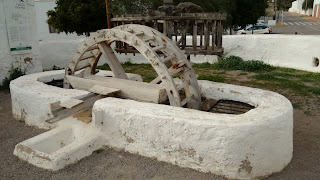We get a lot of our basic shopping in San Jose since it has a supermarket, if a small one, unlike Rodalquilar. One day on our way there, we stopped off in Pozo de los Frailes ('Monks' Well') and looked at the well in the centre of the village. It has been restored and provides an interesting example of the kind of communal amenities that used to be widely used here, right up until recently.
When Juan Goytisolo came through the village in the 1950s, also on his way to San Jose, he watched the well being used:
"After a fifteen-minute descent, a new settlement appears . . . It is Pozo de los Frailes, which has a school and looks bigger than the last one. By the side of the road a blindfolded ass is pulling on the axle of the draw-well. The wheel turns slowly, hoisting bucketfuls of water from the well which are then poured into the trough.
"The children crowd around to see me, and some run-off to tell their mothers. 'A foreigner, a foreigner,' they shout. Women appear out of their hallways; there is an atmosphere of expectation. Rather intimidated, I pretend I'm looking at the cloudlets gathering over the mountains"
The trough Juan mentions, into which the water is channeled:
By chance, we discovered there was another beautifully restored well in the Rodalquilar valley down near El Playazo beach. In this case, it's a double well with an impressive reservoir tank in between the two wheels.
Why it's so far from Rodalquilar village seems a mystery. Maybe it dates back to the alum mining settlement built by Francisco de Vasco at the beginning of the 17th century?
It's right over on the far side of the large bay, there is no obvious path leading to it and no sign to tell you that it's there, which seems strange since the restoration cost nearly a quarter of €1 million! But this is typical of the Cabo!
After the Moors were driven out of Almeria, the people continued to use the aljibes (the Moorish wells and reservoirs) which centuries on can still be seen dotted about the landscape, but De Vasco's settlement was built after the Moors had left and so it would have needed a new water system.










No comments:
Post a Comment